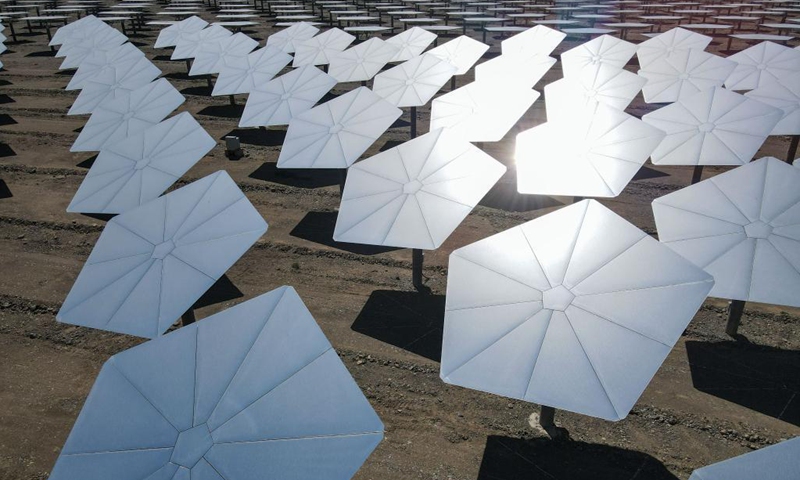
Aerial photo taken on Aug. 22, 2021 shows heliostats at a photothermal power station in Nom Township of Hami, northwest China's Xinjiang Uygur Autonomous Region. The photothermal power station is the first of its kind in Xinjiang. The project is a modern attempt by the region to capitalize on its abundant solar energy and turn it into heat and power. (Xinhua/Gao Han)
China will deepen energy cooperation with partner countries under the Belt and Road Initiative (BRI) in the nuclear, new energy and smart energy sectors, as countries rise to climate challenges, Vice Premier Han Zheng said at the second Belt and Road Energy Ministerial Conference held in Qingdao, East China's Shandong Province on Monday.
The remarks came after a pledge by China in September that it would no longer build new overseas coal power projects as part of its strong commitment to tackling climate change - a solemn statement that immediately drew praise from the international community.
Countries, including Cuba and Morocco, have become the latest members of the Belt and Road energy partnership, according to the National Energy Administration on Monday. The inclusive and newly expanded partnership network now has 32 members and aims to promote energy cooperation in BRI markets as countries pursue a low-carbon transition.
Energy cooperation is a major part of BRI cooperation, and investment in the energy sector accounts for about 40 percent of Chinese investment in BRI countries and regions.
Analysts said China's expertise in developing new-energy sources, as well as its status as a world-class new-energy product supplier, would provide a large number of developing countries that have started a shift toward low-carbon growth and new-energy supplies with ideas and solutions.
They also noted that the proportion of overseas investment in renewable energy will steadily increase as coal-fired plants cease to expand, while demand for energy continues to increase after the resumption of work and production amid a global recovery from the COVID-19 pandemic.
Wang Jifeng, chief engineer with China Southern Power Grid, told the Global Times that 53 percent of the electricity running on its grid is from green energy, due to China's advanced infrastructure such as ultra-high voltage transmission lines that carry electricity over thousands of kilometers.
Ethiopian Ambassador to China Teshome Toga Chanaka told the Global Times that the shift toward new energy requires a combination of several factors - financing, technical capacity and technology - and "BRI energy cooperation fosters regional economic development and low-carbon growth."
The conference on Monday was attended by a large number of officials from partner countries, though most of them participated virtually.
There is no one-size-fits-all approach in this shift toward low-carbon growth, and countries must choose the most suitable approach to their national situations based on best practices around the world, said Uzbekistan's energy minister Alisher Sultanov during the conference via video link.
From 2013 to 2020, China's cumulative direct investment in BRI markets reached $139.85 billion.
Despite the impact of the global pandemic on project construction and personnel exchanges, the energy industry in 2020 was the focus of BRI investment. The proportion of investment in renewable energy, including solar, wind and hydropower rose from 39 percent in 2019 to 57 percent in 2020, and it constituted a major part of China's overseas energy investment, according to media reports.
As wind and solar energy are intermittent, the development of new-energy sources also requires the world to come up with new solutions to tackle the storage of the electricity.
Chinese telecommunication giant Huawei announced over the weekend that it is building a massive energy-storage project in Saudi Arabia with a capacity of 1,300 megawatt hours. The company said the project is a milestone in the global energy storage industry and the largest off-grid energy storage project in the world.
Analysts said that although the pandemic has disrupted the pace of the "going abroad" process, Chinese companies' competitive advantages in solar, wind and hydropower remain unchanged. With the growing market demand for green energy, there will be broadening market scope in wind, solar and pumped-storage hydroelectricity.
China itself has made great strides in tapping new-energy resources. Installed capacity from renewable energy sources reached 42.4 percent of the national total as of the end of 2020, up 14.6 percentage points from 2012.
China has surpassed France as the world's second-largest country in nuclear energy generation after the US, with Chinese nuclear generating units producing 345 billion kilowatt hours a year, according to the World Nuclear Industry Status Report 2021.




